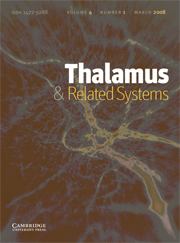Article contents
Thalamocortical connections of the parietal ventral area (PV) and the second somatosensory area (S2) in macaque monkeys
Published online by Cambridge University Press: 12 April 2006
Abstract
Neuroanatomical tracers were injected into two functionally distinct areas in the lateral sulcus of macaque monkeys, the parietal ventral area (PV) and the second somatosensory area (S2). Three of the four injection sites were electrophysiologically determined by defining the receptive fields of neurons at the injection site prior to the placement of the anatomical tracers. Additionally, all locations were confirmed myeloarchitectonically. Labeled cell bodies and axon terminals were identified in the ipsilateral dorsal thalamus and related to nuclear boundaries in tissue stained for cytochrome oxidase (CO) and Nissl substance. Our results indicate that PV receives substantial input from the inferior division of the ventral posterior nucleus (VPi), the anterior pulvinar (Pla), and from the ventral portion of the magnocellular division of the mediodorsal nucleus (MDm), which also is interconnected with prefrontal cortex, the entorhinal cortex and the amygdala. S2 receives input predominantly from VPi, the ventral posterior superior nucleus (VPs), and Pla. These results indicate that PV and S2 are involved in processing inputs from deep receptors in the muscles and joints. Because PV and S2 receive little if any cutaneous input from the thalamus, cutaneous input to these fields must arise mainly through cortical connections. Connectional data supports the proposition that PV and S2 integrate motor and somatic information necessary for proprioception, goal directed reaching and grasping and tactile object identification. Further, PV may play a role in tactile learning and memory.
- Type
- Research Article
- Information
- Copyright
- 2002 Elsevier Science Ltd
- 15
- Cited by


